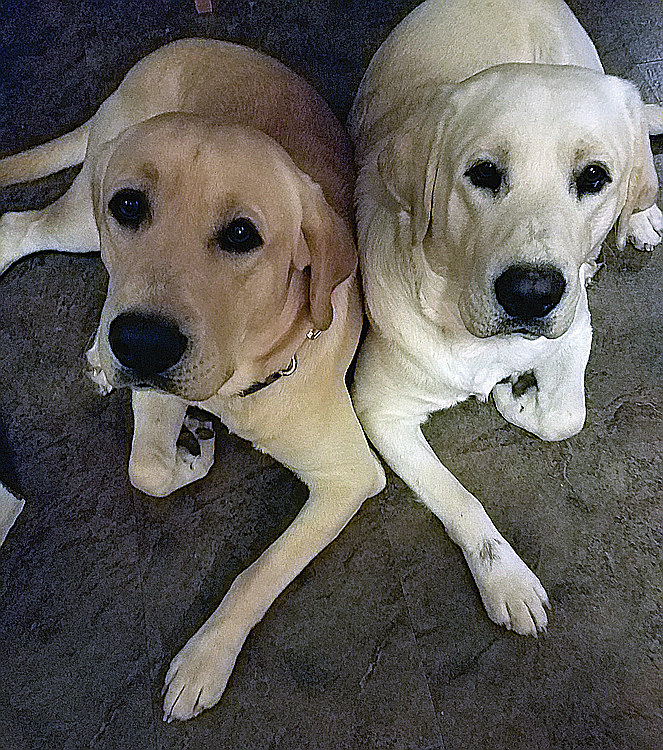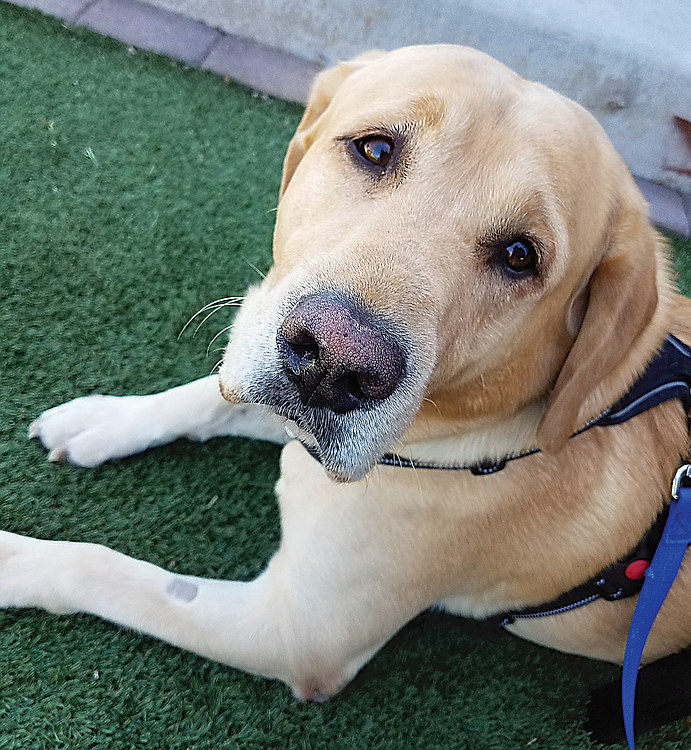By AnnMarie Massimo

Duke and Hondo together
Canine Lymphoma Awareness Day is November 7, 2023. Canine lymphoma is one of the most common cancers in canines.
Canine lymphoma is a cancer of the lymphatic system. This is a network of lymph nodes and lymphatic vessels throughout the body. It is similar to non-Hodgkins Lymphoma in humans.
All dog breeds are affected. Some breeds are at higher risk, like Boxers and Golder Retrievers. The cause of lymphoma in dogs is unknown, but research is ongoing. Some feel it is genetic, some environmental, maybe a virus. Nothing specific has been identified.
What are the symptoms? Your dog may become less energetic, depressed, with loss of appetite, lumps on the body, diarrhea, or vomiting. Some dogs are anemic.
How is it diagnosed? A needle biopsy is done of an enlarged lymph node. The tissue may be tested for T or b-cells. Dogs with T-cells have shorter life spans. Blood work, chest x-ray, and ultrasound of the abdomen may be done to determine the overall health of the dog.
What is the treatment? Sadly, there is no cure. Some dogs may go into remission with chemotherapy. Palliative treatment is an option. Have a heart-to-heart conversation with your veterinarian. Quality of life is the priority. Only you and your veterinarian can make these decisions.
Please allow me to share Duke’s story with you.
In January of 2021, Prescott had one of its epic snowstorms. Duke and his brother Hondo were in hog heaven, running and jumping in the snow and catching snowballs. Two weeks later Duke was down. He collapsed, vomited severely, and was lethargic. I called the veterinarian and was seen that day. While driving to the office, Duke fell sound asleep. My heart sank, as Duke usually is all over the back seat while I’m driving.
We arrived at the office. We are in the middle of the COVID pandemic, so we called the office when we were in the parking lot to check in. Five minutes later, the vet tech called me and asked some basic health questions. A few minutes later she came out to bring Duke in to see the doctor. She immediately said “Oh, what a beautiful dog!”
Duke woke up. He was able to get out of the car on his own. I could not go in with him. He glanced back at me; we had eye contact, and in my mind, I said to be a good boy. I waited in the car.
After 20 minutes, the vet tech came out and said the doctor was working with Duke and wanted permission to do some testing. I said “Do whatever you feel is necessary.”
Waiting again. The doctor came out. She said “Duke is very sick. He is jaundiced, has swollen lymph nodes and has bleeding under his skin. He needs more testing.” Duke was only 5 years old, a yellow Labrador. She said it could be an infection, but she thought it was canine lymphoma.
Duke stayed at the clinic for all the testing needed. I went home and then returned to the clinic to pick him up at 7pm. Duke was given a steroid shot to stop the bleeding and reduce the lymph nodes along with two prescriptions for Prednisone and Pepcid. He was more alert now. Went home and need to wait for all the test results.
Twenty-four hours later, Duke was doing well. No more vomiting, and he had more energy. His lymph nodes were smaller, his tail was wagging. His brother was at his side.
Later that day, the doctor called. The ultrasound showed enlarged lymph nodes in the abdomen and enlarged liver and spleen. No infection. We continued palliative care until all results were in.

Duke during his treatment
Duke settled down for the night with his brother and his blanket. I checked on him throughout the night. He rested well. No more vomiting. The next two days went well. He was acting like his old self.
Saturday morning the doctor called with the pathology results. Duke had high grade Lymphoma Stage 5. My heart sank. How could a dog so full of life have this terrible cancer?
There is no cure for it, but it can go into remission with treatment. He was only 5 years old. Palliative care vs chemotherapy. So much to think about. Since Duke responded so well to Prednisone, and with his young age, chemotherapy was chosen.
The CHOP protocols were started on February 22, 2021. Duke initially did very well. It was a treatment with Intravenous and oral medications over a 25-week period. Duke’s body rejected treatment on week 19. He went back on palliative care. My Dad, his brother, and I provided him with lots of love and support to make each day good for him.
Duke’s last day was August 18, 2021. He woke up that morning and went out into the back yard with his brother Hondo. They walked the whole yard together. He came back into the house and laid down on his blanket and fell asleep forever. One year later, Hondo joined his brother in heaven. Both are forever in our hearts.
A special thank you to Dana Frank, DVM and all her staff for their compassionate care.
Disclaimer: The information in this article is not for medical advice. Its sole purpose is to heighten awareness of this terrible disease.
AnnMarie Massimo is a retired nurse practitioner and beginner freelance writer. She has a great love for animals. Currently she has one cat, two dogs, two geese and four alpacas in her family.

